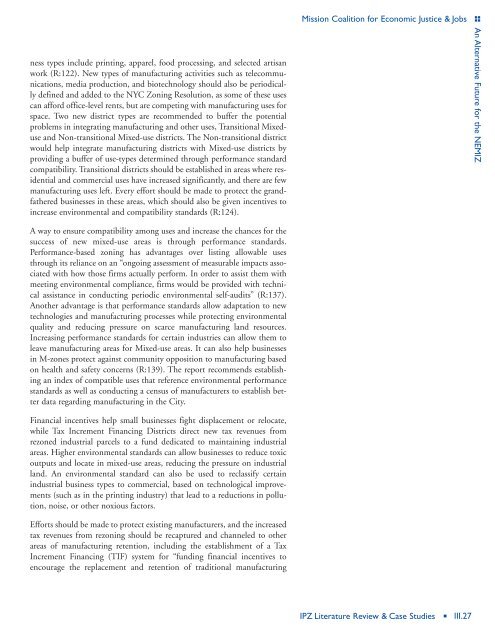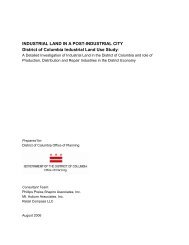An Alternative Future for the North East Mission Industrial Zone
An Alternative Future for the North East Mission Industrial Zone
An Alternative Future for the North East Mission Industrial Zone
Create successful ePaper yourself
Turn your PDF publications into a flip-book with our unique Google optimized e-Paper software.
ness types include printing, apparel, food processing, and selected artisan<br />
work (R:122). New types of manufacturing activities such as telecommunications,<br />
media production, and biotechnology should also be periodically<br />
defined and added to <strong>the</strong> NYC Zoning Resolution, as some of <strong>the</strong>se uses<br />
can af<strong>for</strong>d office-level rents, but are competing with manufacturing uses <strong>for</strong><br />
space. Two new district types are recommended to buffer <strong>the</strong> potential<br />
problems in integrating manufacturing and o<strong>the</strong>r uses, Transitional Mixeduse<br />
and Non-transitional Mixed-use districts. The Non-transitional district<br />
would help integrate manufacturing districts with Mixed-use districts by<br />
providing a buffer of use-types determined through per<strong>for</strong>mance standard<br />
compatibility. Transitional districts should be established in areas where residential<br />
and commercial uses have increased significantly, and <strong>the</strong>re are few<br />
manufacturing uses left. Every ef<strong>for</strong>t should be made to protect <strong>the</strong> grandfa<strong>the</strong>red<br />
businesses in <strong>the</strong>se areas, which should also be given incentives to<br />
increase environmental and compatibility standards (R:124).<br />
A way to ensure compatibility among uses and increase <strong>the</strong> chances <strong>for</strong> <strong>the</strong><br />
success of new mixed-use areas is through per<strong>for</strong>mance standards.<br />
Per<strong>for</strong>mance-based zoning has advantages over listing allowable uses<br />
through its reliance on an “ongoing assessment of measurable impacts associated<br />
with how those firms actually per<strong>for</strong>m. In order to assist <strong>the</strong>m with<br />
meeting environmental compliance, firms would be provided with technical<br />
assistance in conducting periodic environmental self-audits” (R:137).<br />
<strong>An</strong>o<strong>the</strong>r advantage is that per<strong>for</strong>mance standards allow adaptation to new<br />
technologies and manufacturing processes while protecting environmental<br />
quality and reducing pressure on scarce manufacturing land resources.<br />
Increasing per<strong>for</strong>mance standards <strong>for</strong> certain industries can allow <strong>the</strong>m to<br />
leave manufacturing areas <strong>for</strong> Mixed-use areas. It can also help businesses<br />
in M-zones protect against community opposition to manufacturing based<br />
on health and safety concerns (R:139). The report recommends establishing<br />
an index of compatible uses that reference environmental per<strong>for</strong>mance<br />
standards as well as conducting a census of manufacturers to establish better<br />
data regarding manufacturing in <strong>the</strong> City.<br />
Financial incentives help small businesses fight displacement or relocate,<br />
while Tax Increment Financing Districts direct new tax revenues from<br />
rezoned industrial parcels to a fund dedicated to maintaining industrial<br />
areas. Higher environmental standards can allow businesses to reduce toxic<br />
outputs and locate in mixed-use areas, reducing <strong>the</strong> pressure on industrial<br />
land. <strong>An</strong> environmental standard can also be used to reclassify certain<br />
industrial business types to commercial, based on technological improvements<br />
(such as in <strong>the</strong> printing industry) that lead to a reductions in pollution,<br />
noise, or o<strong>the</strong>r noxious factors.<br />
Ef<strong>for</strong>ts should be made to protect existing manufacturers, and <strong>the</strong> increased<br />
tax revenues from rezoning should be recaptured and channeled to o<strong>the</strong>r<br />
areas of manufacturing retention, including <strong>the</strong> establishment of a Tax<br />
Increment Financing (TIF) system <strong>for</strong> “funding financial incentives to<br />
encourage <strong>the</strong> replacement and retention of traditional manufacturing<br />
<strong>Mission</strong> Coalition <strong>for</strong> Economic Justice & Jobs<br />
IPZ Literature Review & Case Studies <br />
III.27<br />
<strong>An</strong> <strong>Alternative</strong> <strong>Future</strong> <strong>for</strong> <strong>the</strong> NEMIZ












